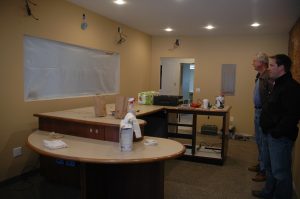NorthEast Radio Watch 12/8/2025: Cichon’s Back in Buffalo
In this week’s issue… Veteran newsman returns - Remembering NY's Leitner, RI's Jones - CT AM saved - Maine AM moves - "Indie" adds suburban signals
by SCOTT FYBUSH
 *So, where were you at 2 PM on Wednesday? The first-ever national test of the Emergency Alert System had broadcasters (and especially broadcast engineers) on alert themselves, waiting to see whether the system would actually work as federal officials attempted to deliver a test message from Washington to every broadcast station, cable operator and satellite provider in the nation.
*So, where were you at 2 PM on Wednesday? The first-ever national test of the Emergency Alert System had broadcasters (and especially broadcast engineers) on alert themselves, waiting to see whether the system would actually work as federal officials attempted to deliver a test message from Washington to every broadcast station, cable operator and satellite provider in the nation.
To hear the mass-media reports after the fact, the test was a failure, and it’s not hard to see why listeners and viewers would have reached that conclusion: if they were in fact paying close attention just after 2, they’d have heard the usual EAS alert tones (the fabled “duck farts”), followed either by dead air in some areas or by muddy, doubled audio in others – and then a few more “duck farts” and right back to normal programming.
But behind the scenes, it’s increasingly clear that for the most part, broadcasters upheld their part of their “voluntary” partnership to help deliver emergency information: the test data and audio delivered from FEMA to the Primary Entry Point (PEP) stations around the region was successfully passed down the daisy chain to most of the local stations expecting to hear it. It’s just that the audio coming into the system was painfully bad – and the fault for that didn’t lie with the broadcasters but rather with FEMA itself, which reportedly fed it to the PEP stations via a garden-variety telephone conference bridge, only to have audio echo back into the bridge from one of the PEP locations.
So what’s to be learned from the test? Beyond the obvious – that there needs to be a better way to get audio to the PEP stations – the FCC and FEMA will be reviewing the mandatory reports from broadcasters to figure out if there were parts of the chain that didn’t deliver the message, however impaired it might have been. State-level emergency planners will also be reviewing the results to see if modifications are needed to the daisy-chain monitoring assignments used by EAS (though it should be noted that many states augment the daisy-chains with their own statewide satellite delivery systems that were not used for the national test). And there’s already talk about augmenting the PEP system with national-alert delivery over existing program paths such as network radio and TV satellite systems.
(As for those reporting requirements: the FCC needs to hear from stations by December 27, either via a written report or through the Commission’s sometimes-confusing forms at its EAS website.)
*The preparations for the EAS test and the reaction to it sucked a lot of the oxygen out of the industry this week, and a four-day week at the FCC made for a light news week otherwise, but here’s what else was making headlines:
 *In NEW YORK‘s capital city, DJR Broadcasting pulled the plug on oldies “Legends 96.7” (WPTR-FM Clifton Park ) on schedule on Friday – and it dropped the venerable callsign, too: the class A FM signal is now WDCD-FM, simulcasting the religious format of sister station WDCD (1540 Albany).
*In NEW YORK‘s capital city, DJR Broadcasting pulled the plug on oldies “Legends 96.7” (WPTR-FM Clifton Park ) on schedule on Friday – and it dropped the venerable callsign, too: the class A FM signal is now WDCD-FM, simulcasting the religious format of sister station WDCD (1540 Albany).
Just up the Northway, Ric Mitchell hung up his headphones Friday after a 38-year run on Albany radio, and 41 years in radio overall. Mitchell was best known for his long runs at WTRY (980 Troy) and WYJB (95.5 Albany), but for the last year and a half he’d been doing mornings at Anastos Media Group’s WQAR (101.3 Stillwater), where he’s now retired.
Christmas music is spreading across the dial in upstate New York: in Albany, WYJB joined the “Jingle Bells” brigade last week, making it the second in the market after WTRY-FM (98.3 Rotterdam). WLZW (98.7 Utica) is now the second all-holiday-tunes signal in that market, following on the heels of Galaxy’s WUMX (102.5 Rome); in Buffalo, WTSS (102.5) and WJYE (96.1) both made the flip last week as well.
Buffalo public broadcaster WBFO (88.7) is one step closer to being sold to crosstown WNED; there’s word that the state comptroller’s office has now signed off on the sale, allowing WBFO’s licensee, the State University of New York, to file with the FCC for the transfer of the WBFO license (and those of its satellite stations in Olean and Jamestown) to WNED. The sale is expected to close next January or February, we hear.
Congratulations to WBEN (930 Buffalo/WLKK 107.7 Wethersfield) newsman Steve Cichon, who’s just been promoted to news director at the Entercom news-talker. In addition to his on-air work at WBEN, Steve’s also renowned for his collection of bowties – and for his other career as a local history author, most recently of the newly-released “Irv! Buffalo’s Anchorman: The Irv, Rick and Tom Story,” a volume we very much need to add to our bookshelf here at NERW Central.
There’s a new addition to the news team at WHCU (870 Ithaca): Katie Husband joins the Saga news-talker as an anchor-reporter, fresh from a stint at WICZ-TV (Channel 40) in Binghamton, and at SUNY Oswego before that. “In a time with cutbacks in news, we’re proud to have a local news team with two reporters, along with News and Program director Geoff Dunn and yours truly,” says WHCU morning host/APD Dave Vieser.

And there’s some more good news from the Southern Tier: as of Friday, Dave Radigan’s WEBO (1330) is back home in downtown Owego, two months after flooding drove the station out of its 57 North Street studio building and up to Dave’s hilltop living room.
WEBO didn’t go back to its old home – instead, it’s now just across the street at 60 North Street, in new studio space that was still very much under construction when NERW stopped by last week. (And we’re pleased to report that after being devastated by the rising Susquehanna River in early September, Owego is rapidly rebuilding; many of the other businesses displaced by the floodwaters have also reopened, helped along by WEBO’s stellar service to its community during and after the flooding.)
*Radio and TV People on the Move in PENNSYLVANIA: Sean McCormick is gone from Beasley’s WRDW (Wired 96.5)/WXTU (92.5), where he was program and promotions coordinator; another former WRDW-FM PD, Leo Baldwin, is the new PD at Radio one’s WHHH (96.3)/WNOU (100.9) in Indianapolis.
Up in Pottsville, Travis Sparks departs WAVT (101.9) after 14 years, most recently on the night shift. In Pittsburgh, former WAMO jock Tracey Lee has joined the new incarnation of WAMO, Tim Martz’s AM 660/100.1 translator, to do middays.
And on TV, Carl Abraham has been promoted to news director of WNEP (Channel 16) in Scranton, capping a nearly 30-year career at the ABC affiliate, while in Johnstown, WJAC-TV (Channel 6) sports anchor Tim Rigby is out after the station decided not to renew his contract; ironically, his last broadcast Thursday came in the midst of by far the largest sports story in the region’s history, just up the road at Penn State.
One more Pennsylvania note: while it’s not being marked on the air, Friday marked the 90th anniversary of Philadelphia’s oldest radio station, KYW (1060). Why no big celebration? Probably because KYW’s legacy in Philadelphia goes back only to 1934, when Westinghouse relocated the station from its birthplace in Chicago – and because the history is further tangled by the complex transaction with NBC that shifted the KYW identity to Cleveland from 1956 until 1965…
*An anniversary that is being acknowledged in NEW JERSEY: it was 25 years ago when Seton Hall University students flipped the format at WSOU (89.5 South Orange) to metal, and today kicks off a “25 Years of Metal” celebration that will include alumni guest DJs, special guests and a concert Friday night at the Starland Ballroom in Sayreville.
 *In CONNECTICUT, former WNLK (1350 Norwalk)/WSTC (1400 Stamford) morning man John LaBarca didn’t take long to resurface after Cox sold those stations to public broadcaster WSHU: as of this morning, he’s doing the morning show at WDJZ (1530 Bridgeport), joining a colorful leased-time lineup that’s been heavy on religion.
*In CONNECTICUT, former WNLK (1350 Norwalk)/WSTC (1400 Stamford) morning man John LaBarca didn’t take long to resurface after Cox sold those stations to public broadcaster WSHU: as of this morning, he’s doing the morning show at WDJZ (1530 Bridgeport), joining a colorful leased-time lineup that’s been heavy on religion.
LaBarca’s new show will air from 7-10 AM on WDJZ, give or take the station’s daytime-only schedule; it’s not yet clear what becomes of LaBarca’s weekend “Italian House Party,” which was originally set to continue on WNLK and WSTC.
*It’s sounding a lot like Christmas in eastern MASSACHUSETTS, where CBS Radio’s WODS (103.3) and Greater Media’s WROR-FM (105.7) both flipped to holiday tunes last week, as they’ve done for the last few years running.
Down the dial a bit, WFNX (101.7 Lynn) is cranking up its celebration of its 28th anniversary: it’s planning an extended “Flashback Weekend” that will start Wednesday, November 23 and wrap up Sunday, November 28, featuring many voices from the alternative rocker’s history.
*It’s rare to hear a new AM station on the air in CANADA, but there’s one in the greater Ottawa area this week: CIRA-5 (1350) began testing on Friday, running 1000 watts by day and 135 watts at night from a transmitter site on the Quebec side of the river. The new signal will eventually be the Gatineau/Ottawa relay of religious “Radio Ville Marie,” CIRA (91.3 Montreal), though for the moment it’s instead simulcasting “Radio Enfant” CJEU (1670), whose transmitter site it shares.
And CIRA-5 could get some new company on the Ottawa AM dial: Papoo Holdings, Inc. has applied for a new 1000-watt signal on 1630 kHz, which will broadcast in at least ten different languages. That application will be heard at a CRTC hearing in Calgary in February, along with an application from Frank Torres (owner of Ottawa’s CIDG, “101.9 DAWG FM,” for a classic hits station in Uxbridge, northeast of Toronto. The Uxbridge station would run 372 watts (900 watts max DA)/140 m.
*There are new FM signals coming to Ontario as well: the CRTC last week approved a new Haliburton Broadcasting-owned hot AC station on 107.9 in Prescott, along the St. Lawrence River across from Ogdensburg, New York, as well as a new signal on 89.7 in Port Hope (adjacent to Cobourg along the Lake Ontario shore) to be run by nonprofit Small Town Radio.
And that’s it for this week! Thanks to the hundreds of you who’ve already subscribed; by now, everyone with a subscription should have a username and password for the site, and next week we’ll begin requiring a login to view most of the weekly NERW column and our 17 years of archives, which will soon be searchable here on the new site. Don’t have your subscription in place yet? It’s easy – just click on “Members” on the menu bar above!
In this week’s issue… Veteran newsman returns - Remembering NY's Leitner, RI's Jones - CT AM saved - Maine AM moves - "Indie" adds suburban signals
In this week’s issue… Scripps stations face takeover - Sinclair moves more affiliations - CT stations sold - Maine AM surrendered - Remembering WVBR's Shapiro, WABC's Morgan
In this week’s issue… CT TV legend succumbs to cancer - Remembering PA's Adams - FCC still stalled by shutdown - Pittsburgh morning host exits
In this week’s issue… FCC faces reopening challenges - Veteran Boston anchor retires - Morning shift in Toronto - NYC FMs expand reach